Oct-31-09
 | | Stonehenge: 6...Na5? Not necessary, not good. |
|
May-27-22
 | | KEG: Eisenberg's questionable opening play led to a difficult--but almost certainly far from hopeless--endgame. Both sides missed chances in the ending, but after Albin's weak 26. Ba5 seemingly gave away his winning chances Eisenberg blundered with 26...Nb6 giving Albin a likely win and then blundered again allowing Albin to reach a rarity: a clearly winning King and Pawn ending though a pawn down. Winning from there was a piece of cake, and Albin quickly sewed up the game. Not a great game by any means, but one with several moments of high drama. 1. e4 e5
2. Nf3 Nc6
3. Bc4 Bd5
4. d3
The Giuoco Pianissimo.
4... d6
5. Nc3
Sound, safe, and normal. 5. Ng5 or 5. c3 are oddball ways to try to grab the advantage. 5... Bg4?
A Janowski favorite, but otherwise shunned. 5...Nf6 is normal and sound. Black could also try 5...Na5 here (much better than on the next move) and seemingly leading to equality. 6. Nd5
This gives White somewhat of an edge, but 6. h3 or 6. Na4 are probably better. The position was now:

click for larger view6... Na5
"?"--(Tournament Book)(<Stonehenge>) I agree with the comment by <Stonehenge>: "Not necessary, not good." Simplest and best for Black is 6...Nge7. Other possibilities are 6...BxN and 6...a5. The text, however, was far from fatal, and Eisenberg's upcoming problems stemmed more from his later errors--and blunders. 7. b4!
Exploiting Eisenberg's last move.
7... NxB
7...Bd4 8. Bb5+ Nc6 9. c3 would be worse still. After the text, Black--though not in super shape--still was very much in the game. 8. bxB

click for larger view8... c6?
This in fact was a bigger mistake than his doubtful 6th move. Black would be--though worse--in a tolerably holdable position with 8...Na5. 9. dxN cxN
10. Qxd5 BxN
11. gxB

click for larger viewWhite's pawns are funky, but he clearly has a strong bind on the position. Black's position, however, was probably not lost...until his next move: 11... Qa5+
11...Nf6 (or maybe 11...Ne7) was best.
12. Bd2 Qxc5
13. Qxb7 Rc8

click for larger viewWhite's pawn structure was a mess here, but he nonetheless had excellent winning chances, which he pretty much forfeited with his next move. |
|
May-27-22
 | | KEG: Post II
14. Qb5+?
Albin would have had fine winning chances with 14. Bb4! Qxc4 15. Rd1. Also strong for White would have been 14. Rg1 g6 15. Bb4 Qc6 16. QxQ+ RxQ 17. 0-0-0. Albin's actual move looks like an over-reaction to his pawn structure problems. His move, however, was weak, and let Eisenberg cure most of his troubles by reducing to an inferior but almost certainly savable endgame. 14... QxQ
15. cxQ Rxc2
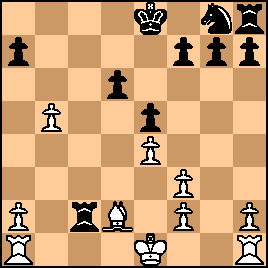
click for larger viewWhite's doubled f-pawns are now more of a strength than a weakness, since he now has play on the g-file. Albin, though no longer in anything like a winning position, may well have been satisfied with a superior ending against a far less experienced and talented player. But that only helps if he plays well. The Tournament Book said that the Black position here was "obviously poor." That, though not entirely without merit, was an overstatement. 16. Be3?
"!"--(Tournament Book)
White has various ways to try to capitalize on his advantage; e.g., 16. Rg1; 16. Ke2 (connecting his Rooks) or perhaps 16. a4. 16. Kd1 also came into consideration. The text seems pointless since the threat to the Black a7 pawn is more illusory than real with the Black Rook on c2 and the chance for the Black h8 Rook to swing into action after 16...Kd7 or 16...Ne7. 16... Rc7?
Perhaps not a true blunder, but missing the chance to bolster his position without fretting about the a7 Pawn Better was 16...Ne7, or perhaps 16...Kd7, in each case preparing for a later Ra8 doubling up the attack on the White a2 Pawn. 17. 0-0 Ne7
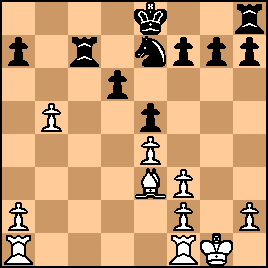
click for larger view18. Rfd1
Wrong Rook! White would have a fine edge with 18. Rad1. Alternatively, White could try 18. f4 and (among other things) fix up his pawn structure and then try for a King-side attack. 18... Nc8
Another weak effort from Eisenberg. He could should play the flexible 18...Kd7 and only go in for Nc8 if White tries to double up his Rooks on the d-file to go after Black's backward d-pawn. The text left:

click for larger view19. a4 Kd7
He might also have tried f5 immediately.
20. Rac1 f5

click for larger view21. a5
21. RxR+ KxR 22. Rc1+ Kb8 23. Rc6 was much stronger. 21... Rb7
22. Rb1 f4
23. Bc5 Ke6
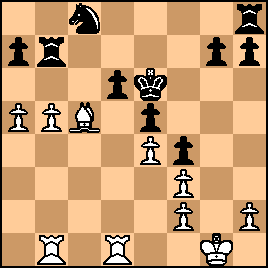
click for larger viewThe Black King was out of the pin, but from here things got interesting...and also sloppy. |
|
May-28-22
 | | KEG: Post III
24. a6!
The best way to keep Black on his heels.
24.. Rc7
"Black could have prevent[ed] the following Bishop maneuver by Rb8." (Tournament Book) Nonsense. The text or 24...Rf7 were correct. By contrast, 24...Rb8? would create additional troubles for Black, and probably lead to a clear loss: e.g., 25. Bxa7!(a pretty positional piece sacrifice which allows White to make progress by repeatedly threatening--but not immediately playing---b7] NxB 26. b6 Nc6 27. Rdc1 Kd7 28. Kf1 Rhf8 29. Rc3 h5 30. h4 Rg8 31. Ke2 Nd4+ 32. Kd3 Ne6 33. b7 (finally!] Nc5+ (forced) 34. RxN! (another sacrifice) dxR 35. a7 Kc7 35. axR (Q)+ KxQ 36. Kc4 and White should win the Rook ending easily. 25. Bb4

click for larger view25... Rc4?
Awful play. This Rook needs to stay home and defend. The text could have led to immediate catastrophe. Black can probably hold with 25...Rd7 or 25...Rd8. 25...g5 is another lively possibility. 25...Rc4? left:

click for larger viewAlbin should now have gone for the jugular with 26. b6! Black is then on the brink of defeat, if not lost: e.g., 26...Nxb6 [forced] 27. Rxd6+ Kf7 [forced] 28. Ba5 Ke7 [forced] 29. Rbd1 Rc1 [forced] 30. Bb4 RxR+ [forced] 31. RxR+ Kf7 32. Bc5 Rb8 33. Rb1 Nd7 [forced] 34. Rb7 Ke6 [forced] 35. Bxa7 Ra8 [forced] 36. Kf1 Kd6 37. Ke2 Rc8 38. Kd3 h5 after which Black will be hard pressed to hold on. But instead of 26. b6!, Albin played:
26. Ba5?

click for larger viewNow Eisenberg could save the day with 26...Ne7. But instead he blundered terribly with: 26... Nb6?
Now, the winning procedure was not hard to find: 27. BxN
Of course.
27... axB
28. Rbc1

click for larger view28... Rhc8?
Awful. 28...Rc5 was the only real chance for Black. 29. RxR RxR
30. Ra1
Eisenberg should surely have seen this coming:

click for larger view30... Rc8
The game looked gone for Black, but then it was Albin's turn to falter: 31. a7?
Plainly premature. White had essentially stopped himself. The win for White now seemed elusive: 
click for larger view31... Ra8
32. Ra6 Kd7

click for larger viewThis may or may not be a win for White with best play. But the next few moves did not represent anything close to "best play." |
|
May-28-22
 | | KEG: Post IV
33. Kg2
"Trying to get on the white diagonal amongst the opponent's pawns. This was a mistake." (Tournament Book) Once again, the Tournament Book was flat out wrong. The text, far from being a mistake, was almost certainly best play and was probably the only clear winning move for White. 33... h5?
"To prevent and entry of the King. This was also a mistake. He should have approached the King to b7, capturing the pawn, as he could not stop the King later on. 33...h5 cost him the game." (Hoffer) Hoffer was correct that 33...h5 was a mistake. But the game was likely lost anyway. After 33...h5, the game was clearly lost for Black, for position now being: 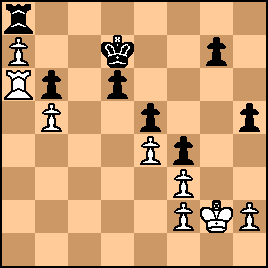
click for larger view34. Kf1?
This may or may not have blown the win, but 34. Kh3! was plainly the killing move. It forces Black to play the weakening g5 in all variations, which gives White targets to exploit. After the text, the win was--at best--difficult. 34... Kc7
Now it is a matter of counting.
35. Ke2
Obviously essential for White to win.
This left:
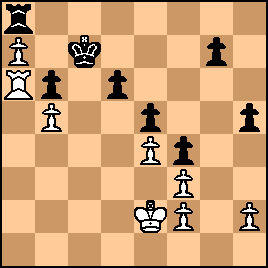
click for larger view35... Kb7?
Now the game was definitely lost for Black. Eisenberg's only chance was a King-side demonstration with 35...g5 or 35...h4 (now that the White King was on e2). 36. Kd3!
Headed for c4 and d5. Black has no good answer, the position now being: 
click for larger view36... Rxa7?
This hastens the end. It leads to a King and Pawn ending that is a clear win for White: 37. RxR+ KxR

click for larger viewWhite is temporarily a pawn down, but with his King about to penetrate, and with the White Pawns on b5 and d4 restraining Black, the game was entirely over. Black is helpless to stop the White advance: 38. Kc4 Kb7
39. Kd5 Kc7
40. Ke6

click for larger viewAs Beth Harmon was told in the Queen's Gambit: "This is where you resign." 40... h4
41. h3 g6
42. Ke7 g5
43. Ke6
1-0

click for larger view |
|
|
|
|





